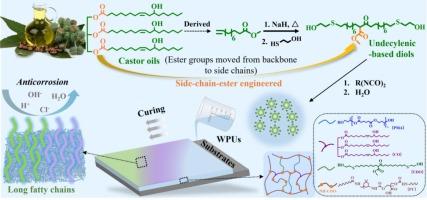Enhancing corrosion resistance of waterborne polyurethanes by incorporation of side-chain-ester engineered vegetable oil diols
IF 7.3
2区 材料科学
Q1 CHEMISTRY, APPLIED
引用次数: 0
Abstract
Vegetable oil-based waterborne polyurethanes (WPUs) demonstrate significant potential as eco-friendly anticorrosion coatings due to their hydrophobic aliphatic chains. However, the hydrolysis susceptibility of backbone-incorporated ester groups inherently derived from vegetable oil structures has been consistently overlooked in corrosion protection enhancement. Herein, we developed structurally engineered diols with side-chain-ester groups, which were systematically incorporated (0–100 %) into WPUs as replacements for petroleum-based polyester glycol, with successful synthesis confirmed by FTIR and SEM-EDS characterization. The emulsions' average particle size (increasing from 25.0 to 137.3 nm), water tolerance (water contact angle increasing from 59.1° to 80.3° with absorption decreasing from 136 % to 31 %), and chemical resistance (icorr decreasing from 1.53 × 10−6 to 5.79 × 10−8 A cm−2) of WPUs were all enhanced by the diols' incorporation. Crucially, side-chain-ester WPUs exhibit superior corrosion resistance versus castor oil-based WPUs (backbone-esters), maintaining structural/spectral stability after 24 h alkaline treatment, while castor oil films degrade (FTIR peak attenuation) and polyester glycol controls fail completely. This work establishes side-chain ester relocation as an innovative molecular design strategy to significantly enhance the corrosion resistance of vegetable oil-based coatings.

通过加入侧链酯工程植物油二醇来增强水性聚氨酯的耐腐蚀性
植物油基水性聚氨酯(wpu)由于其疏水的脂肪链,在环保防腐涂料方面表现出巨大的潜力。然而,天然来源于植物油结构的骨架结合酯基的水解敏感性一直被忽视。在此,我们开发了具有侧链酯基的结构工程二醇,将其系统地(0 - 100%)纳入wpu中,作为石油基聚乙二醇的替代品,并通过FTIR和SEM-EDS表征成功合成。二醇的加入提高了乳液的平均粒径(从25.0 nm增加到137.3 nm)、耐水性(水接触角从59.1°增加到80.3°,吸收率从136%降低到31%)和耐化学性(icorr从1.53 × 10−6降低到5.79 × 10−8 A cm−2)。重要的是,侧链酯wpu比蓖麻油基wpu(骨干酯)具有更好的耐腐蚀性,在碱性处理24小时后保持结构/光谱稳定性,而蓖麻油膜降解(FTIR峰衰减),聚酯乙二醇控制完全失效。本研究建立了侧链酯重定位作为一种创新的分子设计策略,可以显著提高植物油基涂料的耐腐蚀性。
本文章由计算机程序翻译,如有差异,请以英文原文为准。
求助全文
约1分钟内获得全文
求助全文
来源期刊

Progress in Organic Coatings
工程技术-材料科学:膜
CiteScore
11.40
自引率
15.20%
发文量
577
审稿时长
48 days
期刊介绍:
The aim of this international journal is to analyse and publicise the progress and current state of knowledge in the field of organic coatings and related materials. The Editors and the Editorial Board members will solicit both review and research papers from academic and industrial scientists who are actively engaged in research and development or, in the case of review papers, have extensive experience in the subject to be reviewed. Unsolicited manuscripts will be accepted if they meet the journal''s requirements. The journal publishes papers dealing with such subjects as:
• Chemical, physical and technological properties of organic coatings and related materials
• Problems and methods of preparation, manufacture and application of these materials
• Performance, testing and analysis.
 求助内容:
求助内容: 应助结果提醒方式:
应助结果提醒方式:


